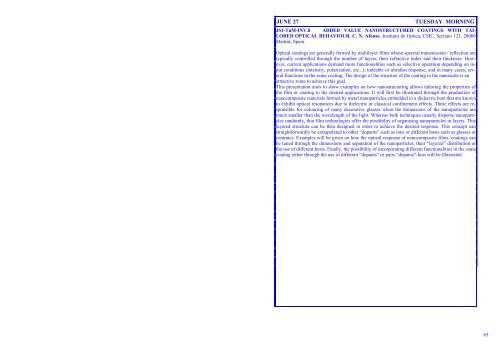Wüest M. 51 Wykes M. 82 Yamaguchi M. 17 Ybarra G. 129 Yubero F ...
Wüest M. 51 Wykes M. 82 Yamaguchi M. 17 Ybarra G. 129 Yubero F ...
Wüest M. 51 Wykes M. 82 Yamaguchi M. 17 Ybarra G. 129 Yubero F ...
Create successful ePaper yourself
Turn your PDF publications into a flip-book with our unique Google optimized e-Paper software.
JUNE 27 TUESDAY MORNING<br />
JS1-TuM-INV.8 ADDED VALUE NANOSTRUCTURED COATINGS WITH TAI-<br />
LORED OPTICAL BEHAVIOUR. C. N. Afonso. Instituto de Optica, CSIC, Serrano 121, 28006<br />
Madrid, Spain.<br />
Optical coatings are generally formed by multilayer films whose spectral transmission / reflection are<br />
typically controlled through the number of layers, their refractive index and their thickness. However,<br />
current applications demand more functionalities such as selective operation depending on input<br />
conditions (intensity, polarization, etc...), tuneable or ultrafast response, and in many cases, several<br />
functions in the same coating. The design of the structure of the coating in the nanoscale is an<br />
attractive route to achieve this goal.<br />
This presentation aims to show examples on how nanostructuring allows tailoring the properties of<br />
the film or coating to the desired applications. It will first be illustrated through the production of<br />
nanocomposite materials formed by metal nanoparticles embedded in a dielectric host that are known<br />
to exhibit optical resonances due to dielectric or classical confinement effects. These effects are responsible<br />
for colouring of many decorative glasses when the dimensions of the nanoparticles are<br />
much smaller than the wavelength of the light. Whereas bulk techniques usually disperse nanoparticles<br />
randomly, thin film technologies offer the possibility of organising nanoparticles in layers. This<br />
layered structure can be then designed in order to achieve the desired response. This concept can<br />
straightforwardly be extrapolated to other “dopants” such as ions or different hosts such as glasses or<br />
ceramics. Examples will be given on how the optical response of nanocomposite films /coatings can<br />
be tuned through the dimensions and separation of the nanoparticles, their “layered” distribution or<br />
the use of different hosts. Finally, the possibility of incorporating different functionalities in the same<br />
coating either through the use of different “dopants” or pairs “dopants”-host will be illustrated.<br />
65
















